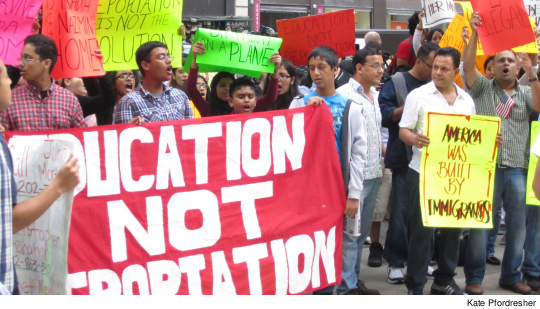 |
Every year, the ranks of seniors graduating from US high schools include 65,000 undocumented immigrants, brought to the US by their parents when they were younger. Many of these young people aspire to attend college and have a career in the country that is now their home.
But their immigration status hinders them in many ways: they are ineligible for almost all scholarships or financial aid; they can’t work legally; and they are under constant threat of detention and deportation. Even if they can’t remember living anywhere else, they have no clear path to citizenship or legal status.
LIVING IN FEAR
“Living in fear, in the shadows, is not a humane way to live your life,” says Emilia Fiallo, 21, an undocumented Hunter College student who came to the US from Ecuador when she was eight years old.
Over the past decade, immigrant youth activists like Fiallo have built a grass roots campaign to win support for the DREAM Act. This reform legislation would offer potential relief to undocumented immigrants who entered the US before the age of 16, have lived in the country five consecutive years, have no major criminal record and have graduated from a US high school or earned their GED. The DREAM Act would give them permission to work and reside in the US, opening a path to citizenship for those who earn a college degree or serve in the military by age 30.
The Act has been blocked in Congress for several years – but the Dreamers (as the young activists are known) saw their fortunes take a potential turn for the better in June when President Obama announced a package of measures that would grant them some interim relief. The President’s executive order came on the heels of escalating protests across the country, in which Dreamers occupied a number of Obama campaign offices.
TEMPORARY PROTECTION
Under the Obama plan, DREAM Act-eligible youth could apply for “deferred action,” which would protect them from deportation for two years and allow them to apply for permission to work. If deferred action is granted, they could renew that status in two-year increments. Their ultimate immigration status, however, would still remain to be determined by Congress.
The executive order applies to individuals who meet the DREAM Act’s criteria and were under 31 years of age on June 15 of this year. The order could affect almost a million immigrants nationwide (out of a total of 11 million undocumented immigrants estimated to be in the US), including roughly 4,500 to 5,000 CUNY students. The government announced that applications would be accepted starting August 15.
“It’s the first time we have seen the conversation move toward justice and away from the restrictionist right wing,” said Alyshia Galvez, an associate professor of anthropology at Lehman and director of the CUNY Institute of Mexican Studies.
Galvez was the keynote speaker at the annual awards dinner of the New York State Youth Leadership Council (YLC) held July 26, 2012. She hailed member-led groups like YLC for putting a face on the immigrant rights movement, with individual activists publicly “coming out” about their immigration status despite the risk of deportation.
The YLC (nysylc.org) is also campaigning for the New York State DREAM Act, which would allow undocumented students who meet in-state tuition requirements to access state financial aid for higher education. To date, they have not been able to gain the support of Governor Andrew Cuomo or the Republican-led State Senate.
With the breakthrough at the federal level, YLC members and other Dreamers must now decide whether to apply for deferred action. Under guidelines put forward by the Citizenship and Immigration Services (CIS) – an agency within the Department of Homeland Security – applicants must undergo background checks and provide biometric data such as fingerprints and retinal scans. The total cost of applying is $465.
Seeking to allay fears about what might be done with the information, CIS has announced that information gathered from applicants will not be shared with Immigration and Customs Enforcement (ICE) or Customs and Border Protection (CBP) for enforcement purposes, even though these two agencies are also part of the Homeland Security Department.
Angy, 21, a sophomore majoring in criminology at John Jay, emigrated to the U.S. from Colombia with her mother when she was three. Her mother has since had three more children, now aged six to 17, who are US citizens by birth. But Angy worries that if she applies, the government may someday round up and deport her mother.
QUESTIONS
“If something happens to me or my mom, I worry what would happen to them,” she said of her siblings. “My mom’s mentality is that as long as I get papers and some relief, that’s OK. She says whatever happens to her is God’s will.”
Emilia Fiallo says she is wary that Obama may be playing “a political game,” but she says she can’t pass on the opportunity. “When you have a promise from someone like the president that offers a ray of light in what is a very dark future, you have to take it and hope for the best,” Fiallo says.
Many community groups are holding meetings to inform undocumented youth about their options. The YLC held deferred action workshops in East Harlem, South Bronx and Jackson Heights in early August, 2012.
Allan Wernick is a professor at Baruch and director of CUNY Citizenship Now, which provides immigrants with legal advice. Wernick said that CUNY Citizenship Now will provide free counseling sessions for undocumented youth at all CUNY campuses within the first six weeks of the new semester. (See cuny.edu/citizenshipnow for details.) The sessions will be staffed by senior attorneys who will be available to advise applicants on their paperwork.
“We’re ambitious. We want to put people through this as soon as we can,” Wernick told Clarion. “It’s an opportunity of a lifetime, and those who are eligible should take it.”

